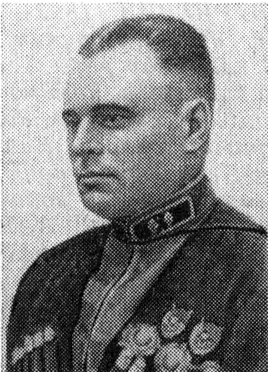Related Research Articles
The 12th Army was a field army of the Red Army formed multiple times during the Russian Civil War and World War II.

The 10th Army of the Soviet Union's Red Army was a field army active from 1939 to 1944.

The cavalry corps of the Workers and Peasant Red Army was a type of military formation that existed from the early days of the Russian Civil War until 1947 when the Red Army was renamed as the Soviet Army and all cavalry corps were disbanded.

Komkor is the abbreviation for Corps commander, and was a military rank in the Soviet Armed Forces of the USSR in the period from 1935 to 1940. It was also the designation for officers appointed to command a corps sized formation.
The 24th Cavalry Division was a cavalry division of the Red Army during the interwar period and World War II. It was a prewar division assigned to the Transcaucasus Military District on 22 June 1941. The division was assigned there after participating in the Winter War.
The 5th Mechanised Corps was a mechanised corps of the Red Army, formed on three occasions. It was first formed in 1934 and was converted into the 15th Tank Corps in 1938. It was reformed in the Far East in 1940 and moved west before the German invasion of the Soviet Union. It fought in the First Battle of Smolensk, losing large numbers of tanks in the Lepel counterattack. The corps was encircled in the Smolensk pocket and after breaking out was disbanded in late August 1941. Its third formation, from elements of the 22nd Tank Corps, occurred in September 1942. The corps fought in: Operation Little Saturn, Operation Gallop, the Second Battle of Smolensk, the Dnieper–Carpathian Offensive, and the Second Jassy–Kishinev Offensive. In September 1944, it became the 9th Guards Mechanised Corps.
The 7th Rifle Corps was a corps in Red Army and Soviet Armed Forces, before and during The Great Patriotic War/World War II.
The 36th Rifle Division was a division of the Red Army and then the Soviet Army. The division was formed in 1919 as the 36th Rifle Division and fought in the Russian Civil War and the Sino-Soviet conflict of 1929. In 1937 it became the 36th Motorized Division. The division fought in the Battles of Khalkhin Gol. It was converted into a motor rifle division in 1940 and fought in the Soviet invasion of Manchuria in World War II. Postwar, it became a rifle division again before its disbandment in 1956. The division spent almost its entire service in the Soviet Far East.
The 4th Rifle Corps was a corps of the Red Army, active from the 1920s.
The 11th Mechanized Corps was a mechanized corps of the Red Army, formed twice. The corps was first formed as one of the original two Red Army mechanized corps from the 11th Rifle Division in Leningrad. In 1934 it was transferred to the Transbaikal Military District and in 1938 became the 20th Tank Corps. The corps was reformed in March 1941 in western Belarus. After the German invasion of the Soviet Union, the understrength corps was destroyed in the Battle of Białystok–Minsk.
The 5th Rifle Corps was a corps of the Soviet Union's Red Army, formed twice.
The 6th Cavalry Corps was a corps of the Soviet Red Army. It was part of the 11th Army. It took part in the Soviet invasion of Poland in 1939.
The 2nd Cavalry Corps were a corps of the Red Army, formed twice. Originally formed in 1922, the corps served in Ukraine during the Interwar period and fought in the Soviet invasion of Poland.
The 4th Cavalry Corps was a cavalry corps of the Soviet Red Army, formed three times.

Yakov Vasilyevich Sheko was a Red Army Komdiv.
Major General Semyon Alexanderovich Tchernetsky was a Russian and Soviet military conductor and the founder of modern Russian military bands. He served as the Senior Director of the Central Military Band of the People's Commissariat of National Defense of the USSR from 1924 to 1950.
The 58th Rifle Division was an infantry division of the Red Army formed during the interwar period. Its second formation during World War II gained the Oder honorific.

Pyotr Nikolayevich Akhlyustin was a Red Army major general.

Andrey Grigoryevich Nikitin was a Red Army major general.
The 3rd Cavalry Division was a military unit in the Workers' and Peasants' Red Army of the Armed Forces of the Union of Soviet Socialist Republics.